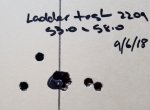Hi all. I have changed the way I do load development and have for the first time tried out a ladder test. I assume I'm meant to see points of impact tracking up the target, so how do I interpret this?
140 gr Barnes TTSX, 43.0 - 58.0 gr AR2209 (H4350) 10 shots, increasing in 0.5 increments shot at 100 metres. Fired from a Kimber MA .280AI. This rifle is new to me so some of the shots could be wiggle. Through the 8x I couldn't see much of what was going on but I know the highest hole is the hottest with 58gr; I thought I was off the paper for most of the shots until I walked up to it.
Cheers
Dan

140 gr Barnes TTSX, 43.0 - 58.0 gr AR2209 (H4350) 10 shots, increasing in 0.5 increments shot at 100 metres. Fired from a Kimber MA .280AI. This rifle is new to me so some of the shots could be wiggle. Through the 8x I couldn't see much of what was going on but I know the highest hole is the hottest with 58gr; I thought I was off the paper for most of the shots until I walked up to it.
Cheers
Dan

